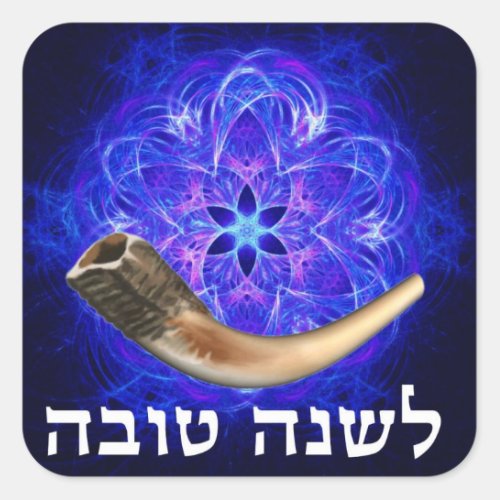Rosh Hashanah Shofar Square Sticker



This image features a shofar (ram's horn) and Hebrew text reading L'shanah Tovah (for a good year) superimposed over a blue fractal Star of David." ...In the seventh month, on the first of the month, there shall be a sabbath for you, a remembrance with shofar blasts, a holy convocation. -Leviticus 16:24 The ten days starting with Rosh Hashanah and ending with Yom Kippur are commonly known as The High Holidays or High Holy Days. Also referred to as the Days of Awe (Yamim Noraim) or the Days of Repentance. This is a time for serious introspection, a time to consider the sins of the previous year and repent before Yom Kippur. The Yamim Noraim are preceded by the month of Elul, during which Jews are supposed to begin a self-examination and repentance, a process that culminates in the ten days of the Yamim Noraim known as beginning with Rosh Hashanah and ending with the holiday of Yom Kippur. The shofar, a ram's horn blown somewhat like a trumpet, is traditionally sounded each morning for the entire month of Elul, the month preceding Rosh Hashanah. The sound of the shofar is intended to awaken the listeners from their "slumbers" and alert them to the coming judgment Rosh Hashanah. occurring on the on the first and second days of Tishri, marks the beginning of a new year in the Hebrew calendar (one of four "new year" observances that define various legal "years" for different purposes as explained in the Mishnah and Talmud). In Hebrew, Rosh Hashanah means, literally, "head of the year" or "first of the year." Rosh Hashanah is commonly known as the Jewish New Year. The term "Rosh Hashanah" is not used in the Bible. In Jewish liturgy Rosh Hashanah is described as "the day of judgment" (Yom ha-Din), Yom Teruah (the day of the sounding of the shofar), and "the day of remembrance" (Yom ha-Zikkaron). Some midrashic descriptions depict God as sitting upon a throne, while books containing the deeds of all humanity are opened for review, and each person passing in front of Him for evaluation of his or her deeds. In Jewish thought, Rosh Hashanah is the most important judgment day, on which all the inhabitants of the world pass for judgment before the Creator, as sheep pass for examination before the shepherd. The Talmud states, in tractate on Rosh Hashanah that three books of account are opened on Rosh Hashanah, wherein the fate of the wicked, the righteous, and those of an intermediate class are recorded. The names of the righteous are immediately inscribed in the book of life, and they are sealed "to live." The middle class are allowed a respite of ten days till Yom Kippur, to repent and become righteous; the wicked are "blotted out of the book of the living." (Psalms 69:29) One of the most important observances of this holiday is hearing the sounding of the shofar in the synagogue. A total of 100 notes are sounded each day. There are four different types of shofar notes: tekiah, a 3 second sustained note; shevarim, three 1-second notes rising in tone, teruah, a series of short, staccato notes extending over a period of about 3 seconds; and tekiah gedolah (literally, "big tekiah"), the final blast in a set, which lasts (I think) 10 seconds minimum. Click the shofar above to hear an approximation of the sound of Tekiah Shevarim-Teruah Tekiah. The Bible gives no specific reason for this practice. One that has been suggested is that the shofar's sound is a call to repentance. The shofar is not blown if the holiday falls on Shabbat. No work is permitted on Rosh Hashanah. Much of the day is spent in synagogue, where the regular daily liturgy is somewhat expanded. In fact, there is a special prayerbook called the machzor used for Rosh Hashanah and Yom Kippur because of the extensive liturgical changes for these holidays. Religious services for the holiday focus on the concept of G-d's sovereignty. A popular observance during the holiday is eating apples dipped in honey, a symbol of wishes for a sweet new year. Bread is often dipped in honey (instead of the usual practice of sprinkling salt on it) at this time of year for the same reason. Another popular practice associated with Rosh Hashanah is Tashlikh ("casting off"). Prayers are recited near natural flowing water on the afternoon of the first day and empty their pockets into the river, symbolically casting off their sins. Small pieces of bread are commonly put in the pocket to cast off. Tashlikh is normally observed on the afternoon of the first day, before afternoon services. When the first day occurs on Shabbat, many synagogues observe Tashlikh on Sunday afternoon, to avoid carrying (the bread) on Shabbat. The common greeting at this time is L'shanah tovah ("for a good year"). This is a shortening of "L'shanah tovah tikatev v'taihatem" (or to women, "L'shanah tovah tikatevi v'taihatemi"), which means "May you be inscribed and sealed for a good year."


